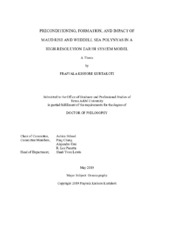| dc.contributor.advisor | Stoessel, Achim | |
| dc.creator | Kurtakoti, Prajvala Kishore | |
| dc.date.accessioned | 2020-03-10T20:44:09Z | |
| dc.date.available | 2021-05-01T12:34:57Z | |
| dc.date.created | 2019-05 | |
| dc.date.issued | 2019-04-18 | |
| dc.date.submitted | May 2019 | |
| dc.identifier.uri | https://hdl.handle.net/1969.1/187569 | |
| dc.description.abstract | Open ocean polynyas (OOPs) in the Southern Ocean are ice-free areas within the winter ice pack that are associated with deep convection, potentially contributing to the formation of Antarctic Bottom Water (AABW). To enhance the credibility of Earth System Models (ESMs), their ability to simulate OOPs realistically is thus crucial. Here we investigate OOPs that emerge intermittently in a high-resolution (HR) pre-industrial simulation with the Energy Exascale Earth System Model (E3SMv0), an offspring of the Community Earth System Model (CESM). While low-resolution (LR) simulations with E3SMv0 show no signs of OOP formation, the preindustrial E3SMv0-HR simulation produces both small Maud Rise polynyas (MRPs) as well as large Weddell Sea polynyas (WSPs). The former is associated with a prominent seamount in the eastern Weddell Sea, and their preconditioning and formation is the focus of the first part of this dissertation. The second part of my dissertation is on the generation of WSPs in the same preindustrial E3SMv0-HR simulation. While the formation of MRPs requires HR to simulate the detailed flow around Maud Rise, a realistic simulation of WSPs requires the ability of a model to produce MRPs. Furthermore, WSP formation will not occur without a prolonged build-up of a heat reservoir at depth, and a prolonged period of less negative wind stress curl in association with the core of the southern hemisphere westerlies being located at an anomalously northward position. The third part of my dissertation discusses the potential effects of AABW anomalies due to WSPs on the Atlantic Meridional Overturning Circulation (AMOC). Earlier studies indicate these anomalies propagate relatively fast along the deep western boundary in the form of internal boundary waves. Since the simulation contains 2 major WSP events that prevail over several years, their impact on AABW anomalies along the deep western boundary can readily be traced. However, they do not seem to affect the outflow of North Atlantic Deep Water (NADW) to the extent of a noticeable impact on the strength of the AMOC. It is hypothesized that this is because of the eddy-resolving capability of E3SMv0-HR, and HR in general leading to a confined deep western boundary current.
* Partly published in AMS Journal of Climate (Kurtakoti et al., 2018). | en |
| dc.format.mimetype | application/pdf | |
| dc.language.iso | en | |
| dc.subject | Open Ocean Polynyas | en |
| dc.subject | Maud Rise Polynyas | en |
| dc.subject | Weddell Sea Polynyas | en |
| dc.subject | Southern Ocean Convection | en |
| dc.subject | Taylor cap | en |
| dc.subject | Bottom water formation | en |
| dc.subject | Southern Hemisphere Westerlies | en |
| dc.subject | Open ocean convection | en |
| dc.title | Preconditioning, Formation, and Impact of Maud Rise and Weddell Sea Polynyas in a High-Resolution Earth System Model | en |
| dc.type | Thesis | en |
| thesis.degree.department | Oceanography | en |
| thesis.degree.discipline | Oceanography | en |
| thesis.degree.grantor | Texas A&M University | en |
| thesis.degree.name | Doctor of Philosophy | en |
| thesis.degree.level | Doctoral | en |
| dc.contributor.committeeMember | Chang, Ping | |
| dc.contributor.committeeMember | Panetta, Lee | |
| dc.contributor.committeeMember | Orsi, Alejandro | |
| dc.type.material | text | en |
| dc.date.updated | 2020-03-10T20:44:10Z | |
| local.embargo.terms | 2021-05-01 | |
| local.etdauthor.orcid | 0000-0002-1499-5980 | |


